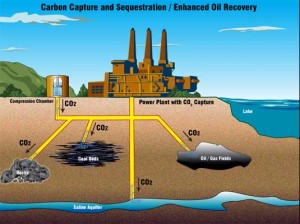Carbon capture and storage (CCS) — in geological formations deep underground — is one of the major options proposed by advocates of natural gas and ‘clean coal’ technology as a way to limit future emissions from coal and gas-fired power plants.
 A new study highlighted on the cover of this week’s Nature
A new study highlighted on the cover of this week’s Nature
answers important questions about what happens to buried CO2 over the long term.
The authors studied a range of natural gas fields around the world where carbon dioxide has been trapped underground for millions of years. They found that the majority of the gas dissolves in surrounding groundwater, rather than becoming trapped in mineral form.
In other words, their findings imply that sequestering CO2 in geological formations would produce vast quantities of highly CO2-enriched sparkling water.
An accompanying News & Views article states:
“The safety of geological storage of CO2 is obviously a central concern in planning carbon sequestration on a large scale….Although dissolution in groundwater implies the possibility of CO2 transport and eventual leakage to the atmosphere, as is thought to occur in natural gas fields, this result does not mean that safe geological storage is impossible. But it highlights the need for a thorough assessment of the hydrogeological setting of prospective storage sites.”
To access a copy of the article and the accompanying perspective piece, contact the Science Media Centre on (04) 499-5476 or smc@sciencemediacentre.co.nz
The SMC has asked scientists studying carbon capture and storage to send us comments on the new research.
(UPDATED)
Shannon Page, Arthur Williamson, Ian Mason of the University of Canterbury comment:
“This research is a significant contribution to our understanding of what happens to CO2 when it is stored in an underground aquifer.
“However, from an engineering point of view, it does not bring the practical implementation of carbon capture and storage any closer. Whilst this paper does provide data for computer modelling, the urgent need is to move into practice.
“In this respect it should be noted that there are as yet no coal fired power stations with complete CCS system anywhere in the world. An integral part of a successful system is an suitable and appropriately located storage site and much more work is urgently needed in this area, if this technology is to make meaningful contributions to timely emissions reductions.
“The evidence to date is that CCS is unlikely to be widely implemented before 2030. An alternative strategy is to redirect the time and money available to develop long term solutions which would thereby eliminate the need for CCS. We see enormous opportunities to use the talents and enthusiasm of the engineering profession, and others, to take us to a truly sustainable future.”
Dr Sadiq Zarrouk, Senior Lecturer at the Geothermal Institute, Department of Engineering Science at University of Auckland:
“Interesting work. The implications to New Zealand given its high seismic nature is that CO2 can be stored in deep reservoirs (depleted oil or gas, saline aquifers and geothermal systems) without major emphasis on cap rock (confining formations). This could ease site selection criteria.”
Rob Funnell, Team Leader – Basin Modelling at GNS Science:
“This research is great news and strongly supports the research being undertaken to evaluate potential underground sites for carbon dioxide storage around the world. It confirms work presented by the IPCC, IEA and CO2CRC, where saline aquifers have been identified as providing the greatest opportunities for carbon dioxide storage, compared to depleted oil and gas fields or storage in coal systems.
In New Zealand, researchers funded by a joint industry and government steering group and the Australian CO2CRC have examined whether New Zealand rocks have the capacity to store CO2 safely. These studies, which include researchers from GNS Science, University of Auckland, CRL Energy, and the CO2CRC will be shortly released in a series of reports and results so far are encouraging.
These storage capacity estimates have been conducted in tandem with research to understand the impact of storing CO2 underground, and to minimise the risks associated with the development of CCS in our unique tectonically active environment.”
A group of researchers* at the University of Canterbury have published an alternative view of the future of CCS in New Zealand. Here is an excerpt from their paper in the journal Energy Policy:
“It appears unlikely that CCS will deliver significant CO2 reductions in a timely fashion. In addition, many uncertainties remain over the permanence of CO2 storage, either in geological formations, or beneath the ocean. We conclude that further investment in CCS should be seriously questioned by policymakers.”
Page, S.C., et al., Carbon capture and storage: Fundamental thermodynamics and current technology, Energy Policy (2008), doi:10.1016/j.enpol.2008.10.028
They also recently presented a conference paper entitled: Carbon Capture and Storage: An appropriate technology for New Zealand? (PDF file)
*Shannon Page, Ian Mason and Arthur Williamson